THE ORDER PRIMATES
Primates – Mammals of the First Order (About 180 species)
Some 195 species of lemurs and their kin, monkeys, apes, and man, together constitute the primates. They are essentially tropical in distribution, found in the Americas, Africa, and southern Asia, although man has extended the distribution to the coldest of polar expeditions – indeed even to extraterrestrial orbs.
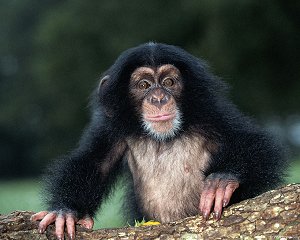
Primates evolved from ancient insectivores and for the most part, retained their arboreal habits. There has been considerable development of the brain, and a rounded braincase to go with it. The sense of sight is acute, the eyes being large and facing forward to provide the depth of vision, called 3-D or stereoscopic vision, while the senses of hearing and smell are reduced. A relatively flattened face has resulted.
Grasping hands and feet with flat nails rather than claws occur in most primates, as do the daytime activity and an omnivorous diet. Many primates are capable of breeding the year around and usually bear only one young per year.
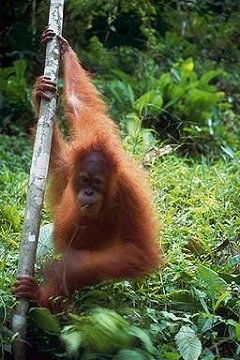
Primates have had to evolve a comparatively complex social organization to provide for breeding and particularly for the raising of young, which are born in a helpless state and develop very slowly.
The more advanced monkeys and apes from the suborder Anthropoidea (manlike), while all the other primates, those less advanced, are given their own suborder, Prosimii (before apes). A wide variety of small and intermediate-sized primates constitute the six families of prosimians. They are the mouse lemurs, true lemurs, indris, the aye-aye, lorises and bushbabies, and tarsiers.
The first four are found only on the island of Madagascar, the loris family inhabits southern and southeastern Asia and Africa, and the three species of tarsiers are native to Sumatra and Borneo, Celebes, and the Philippine island of Mindanao. Second to the tiny tree shrew, the smallest of the prosimians is the mouse lemur. As its name implies, it is the size of a mouse.
Some species of lemurs and indris are diurnal in the habit (active during the daytime) and active on the ground, but most prosimians are nocturnal and at home in the trees.
Their diets are varied. The indris eat leaves, as do the mouse lemurs, who add fruit and insects to their meals. All other prosimians are insectivorous, while lorises prey upon small birds and lizards as well. The aye-aye has specially adapted fingers for extracting insect larvae from crevices, and several other prosimians have remarkably specialized hands and feet or hind limbs.
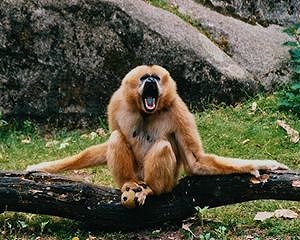
Owing to the clearing of their forest habitat for agriculture, the unique prosimians of Madagascar may not survive much longer in the wild state.
The more advanced primates, or anthropoids, are conveniently classified into five families. Almost all species are diurnal inhabit, in contrast to the prosimians and are among the more familiar primates.
The New World primates of Central and South America are classed in the family Cebidae. The most common in the tropical forests of South America comprise marmosets and tamarins. The tiny marmosets range from mouse to squirrel size, and scamper, twittering, through the trees in small family groups searching for fruit, insects, lizards, small birds, and eggs.
Also in the family Cebidae are the New World monkeys: the small squirrel monkey, the larger nocturnal owl monkey and sakis, spider monkeys, and the 20-pound howler monkeys (see above). All have long, well-haired tails except the rare uakaris. Cebids have long, narrow limbs; some lack an opposable thumb; but all have a strongly opposable big toe.
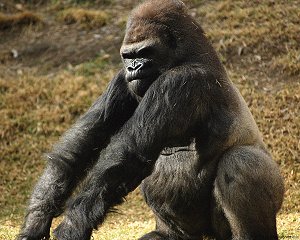
Their eyes face forward, but the nostrils are usually widely separated and face to the side; the so-called platyrrhine (flat-nosed) characteristic sometimes cited as a distinction between New World and Old World monkeys. Another difference is the lack of colorful calluses on the rump seen in some Old World species. Cebids, particularly male howler monkeys, are often heard rather than seen as they call in resounding voices while roaming in large troops through the forest.
They are primarily fruit-eaters, although cebids enjoy other plant matter too, and some eat insects, lizards, small mammals, and birds’ eggs as well.
All Old World monkeys, but not apes and man, are grouped in a second family, and the largest: the Cercopithecidae. All together comprising some 76 species, the family ranges from northwest Africa through Africa south of the Sahara, southern Arabia, and southern and southeastern Asia to Timor, the Philippines, and Japan. Old World monkeys obviously tolerate greater cold than do their New World cousins, as is demonstrated by the Japanese macaque, which lives in the snow of northern Honshu.
These monkeys are fairly large, weighing from about 3 pounds to a record 119 pounds for a male mandrill, and are distinguished by a catarrhine feature, that is, having the nostrils close together and opening downward. They also have large, sometimes exceptionally long, upper canines, and an opposable thumb and big toe, except for the colobus monkeys, whose thumb is vestigial or lacking. Many of these species have large, bare, red calluses on their rumps.
They eat a variety of foods, depending upon the species. Although most are arboreal in habit, baboons are terrestrial, and macaques are equally capable in trees or on the ground. Old World Monkeys are mainly diurnal and often live in large social troops. Besides baboons, mandrills, macaques, and colobus monkeys, this family includes mangabeys, the gelada, guinons, patas monkeys, and langurs.
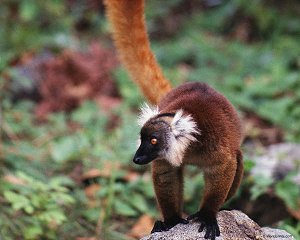
The colobus and langurs are leaf-eaters and have more elaborate digestive systems than other monkeys, so they are placed in a distinct subfamily.
Six species of gibbons make up a separate family, distinguished from the great apes in particular by their highly developed brachiating ability – that is, the ability to travel rapidly through the trees swinging by their arms from branch to branch. They range throughout southeast Asia to Sumatra and Borneo.
The most highly advanced primates next to man are in the family Pongidae: the orangutan, two species of chimpanzees, and the gorilla. The orangutan, rapidly disappearing, is native to Sumatra and Borneo. The chimpanzees and gorillas inhabit west and central equatorial Africa.
Pongids have a fairly rounded skull, large braincase, and the same dental formula as a man. The great apes are mostly vegetarian in their diet and known to be carnivorous on occasion. Unlike the gibbons, these apes are terrestrial, and although able to walk bipedally are usually quadrupedal.
Human beings are the only living species of the family Hominidae, truly bipedal primates with opposable thumps, large braincase, and enlarged cerebrum, and with the skull opening downward as a result of standing upright.
Check out the following specific primates included:
Black Lemur
Ringtailed Lemur
Mouse Lemur
Indri
Aye-aye
Potto
Slender Loris
Slow Loris
Bushbaby
Tarsier
Owl Monkey
Howler
Capuchin
Squirrel Monkey
Spider Monkey
Wooly Monkey
Uakari
Saki
Tamarin
Common Marmoset
Pygmy Marmoset
Lion Marmoset
Rhesus
Macaque
Mangabey
Gelada Baboon
Baboon
Mandrill
Vervet
Owl faced Monkey
Patas
Langur
Proboscis Monkey
Colobus
Siamang
Gibbon
Orangutan
Chimpanzee
Gorilla
